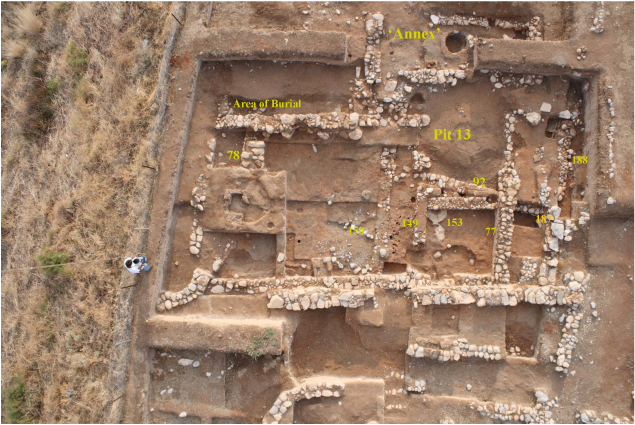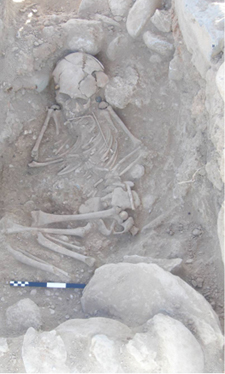|
|
|
LEFKANDI-XEROPOLIS 2008 SEASON– Region I The LH IIIC ‘Megaron’ and it Early Iron Age Successor Our main focus this year was to remove the floors of the Late Helladic IIIC predecessor and to recover any of its internal fixtures. In the course of the excavation, a better appreciation of the LH IIIC building was made possible. In addition, the existence – long suspected – of additional structures to the East was confirmed (see under Annex).
In the South and the middle section of Area M, we encountered walls of a structure dated to the LH IIIC – Lefkandi phase 2a. It is set on the skewed (NW/SE) grid and thus matches with other contemporary houses discovered in the earlier excavations (see Lefkandi IV) and our own. The structure was equipped with clay bins and pebble floors which are typical of the period. Some break in occupation, however, may be postulated because of the existence of sundry traces of later activities. When the area was re-occupied, two important differences are evident which have already been noted in the 2007 report. The first was an alteration to the orientation of the building, which now changes to the North/South lines of the excavation grid. This change took place most probably during Lefkandi-Phase 2b when a number of other house in this part of Xeropolis maintain the earlier grid lines.
The second change is the plan of the building: it is now a long, rectangular structure. It should be noted that we do not have its North end – due to the erosion of the hill and the construction of a Late Geometric house there – and thus we cannot be sure whether it had an apsidal end or not. These indications of change are further underlined by the presence of likely subsidiary structures on the same lines to the East (see ‘Annex’). In terms of its internal arrangements, the Late Geometric pit, Pit 13 (cut through the South/East sector of the structure) has wrecked most of the southern porch regions. It is not clear where the main entrance of the LH IIIC ‘Megaron’ was, since its South end has vanished after the construction of the Early Iron Age building. An alternative or second entrance could be sought in the area of the ‘Annex’ at the East. Nevertheless, if one entered the building from the South, one would have walked into a room at the South/East and from there could have moved into the East side where a main room occupied the whole width of the structure (a space of 7 x 5 m). The duration of occupation of the LH IIIC ‘Megaron’, as indicated by the pottery, is not fully studied yet: it certainly includes White Ware of Lefkandi Phase 2b/3, but its chronological limits need to be assessed better. Neither is the reason for its abandonment clear, but it was thoroughly cleared out. The question of how long a period of time passed between this and the erection of the Early Iron Age successor remains equally a matter for further study of both the stratigraphy and the ceramics. This year’s investigations to the East of the LH IIIC and the Early Iron Age buildings revealed more about the structure which has been named the ‘Annex’. This structure seems to follow closely the history of occupation of both the LH IIIC and the EIA ‘Megara’. The LH IIIC structure was probably entered directly from the East wall of the ‘Megaron’ and has a broadly rectangular form, running North/South (some 3 x 6 m). Of the overlying EIA plan a little more is known. It is narrow for its length as was the LH IIIC version, and it does not resemble a normal room as known in any contemporary house: hence the suggestion that it was being used for storage purposes. This may not be, however, the whole story. Further to the East of the so-called 'Annex', other similar in construction walls argue for the existence of further rooms. These were not investigated due to lack of time but they raise the intriguing possibility that there was a series of ancillary rooms or units to serve the needs of the ‘Megaron’ – during both its LH IIIC and Iron Age phases. If this is the case, such an occurrence is yet another indicator of the high status of the occupants of the ‘Megara’. Further excavation is necessary here to confirm such suggestions and to understand better its implications for the spatial organization of the area. Finally, to the North and just outside the ‘Megaron’, was found the flexed skeleton of a young girl (to judge from the finds of two pins found on the shoulders, a conical button and a pierced shell). The head had been held in place by two stones, one supporting it on each side. The date of the burial is hard to determine stratigraphically: it ought to be later than the pre – LH IIIC building. This agrees with the date of the pins which can be assigned to the LH IIIC middle to late period.
Home > New Excavations >2008 Season > 2008 Season Region I> History of Research> Cemeteries
Copyright © 2009, http://lefkandi.classics.ox.ac.uk/ |


 Three pits were found within the so-called Annex – one (Pit 47) is of a Sub-Mycenaean – Early Protogeometric date, the other (Pit 48), a bit later in the Protogeometric period. Neither of them is very large (at most 80 cm across and 40 cm deep), but their contents are intriguing: Pit 48 yielded bones of large animals and a lot of ceramics: they might be the remains of an event involving feasting. Most of the pots so far studied are open vessels such as skyphoi and cups.
Three pits were found within the so-called Annex – one (Pit 47) is of a Sub-Mycenaean – Early Protogeometric date, the other (Pit 48), a bit later in the Protogeometric period. Neither of them is very large (at most 80 cm across and 40 cm deep), but their contents are intriguing: Pit 48 yielded bones of large animals and a lot of ceramics: they might be the remains of an event involving feasting. Most of the pots so far studied are open vessels such as skyphoi and cups.